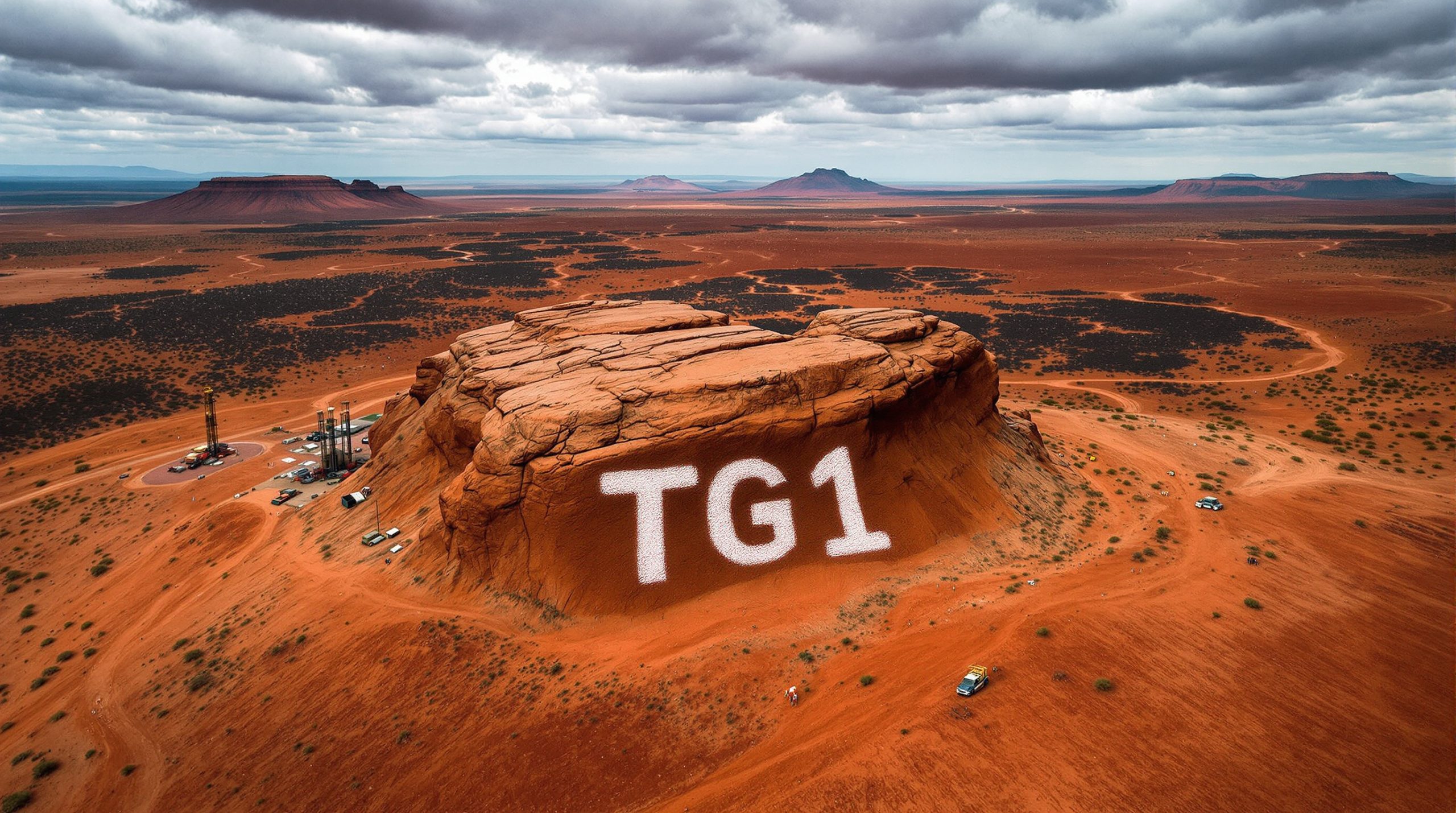Litchfield Minerals Limited (ASX: LMS) has delivered a significant breakthrough at its Northern Territory copper-gold project, intersecting 46 metres of lightly disseminated copper-iron sulphides at the VT1 conductor target. The discovery represents a major milestone where Litchfield Minerals discovers sulphide zone development, marking a crucial step forward in validating what appears to be a large-scale hydrothermal system with multi-kilometre alteration corridors spanning the Oonagalabi Project.
Initial geological logging and handheld portable X-ray fluorescence (pXRF) analysis from the 69-metre depth revealed a substantial sulphide package dominated by pyrrhotite-pyrite-chalcopyrite mineralisation. While awaiting laboratory confirmation, this intersection significantly strengthens the geological model pointing to an intrusion-related hydrothermal system with widespread copper-zinc-gold-silver potential.
Managing Director Mathew Pustahya highlighted the significance of the discovery where Litchfield Minerals discovers sulphide zone intersection:
"The observed sulphide concentration can't account for the targeted conductor's strength, however, we believe we're close. Our data-driven programme of DHEM, IP and ground EM is designed to zero in on the best zones quickly."
Key Discovery Metrics:
- 46-metre sulphide intersection from 69m depth
- VT1 conductor strength: up to 700 Siemens
- Surface geochemistry: 0.6% Cu, 0.6 g/t Au, 14g/t Ag, 7 g/t Te
- Target scale: Over 400m long conductor complex
Understanding VTEM Technology: The Foundation of Modern Mineral Exploration
Versatile Time Domain Electromagnetic (VTEM) surveys represent cutting-edge airborne geophysical technology essential for identifying subsurface conductor plates that may host valuable mineral deposits. The system operates by creating electromagnetic fields that detect conductive mineralisation, particularly sulphide deposits containing copper, zinc, and precious metals.
Furthermore, VTEM provides cost-effective reconnaissance over vast areas, identifying drill targets with mathematical precision rather than relying on surface observations alone. The technology works by flying aircraft equipped with electromagnetic transmitters and receivers at approximately 200 kilometres per hour over prospective terrain. These instruments measure the Earth's electromagnetic response to identify buried conductive bodies that could indicate mineral deposits.
However, as the case where Litchfield Minerals discovers sulphide zone development demonstrates, airborne surveys require ground-truthing through more precise techniques. Downhole Electromagnetic (DHEM) surveys provide exact targeting by placing receivers directly in drill holes to measure electromagnetic responses with greater accuracy. This technological progression from broad detection to precision targeting represents standard industry practice for maximising drilling efficiency and capital deployment.
The VT1 Technical Challenge
Unlike the simpler VT2 target modelled as a single 500-metre-plus conductor, VT1 comprises six individual conductive plates within complex folded stratigraphy. This geological complexity requires sophisticated interpretation and multiple drilling angles to fully understand the subsurface geometry. Consequently, the challenge illustrates why systematic exploration approaches prove essential for complex geological systems.
Systematic Exploration Programme Accelerates Discovery Timeline
Litchfield has structured what the company describes as a 3-5 month intensive exploration programme designed to resolve the geological puzzle rapidly. The systematic approach contrasts sharply with typical industry timelines of 12-24 months for similar scope projects, potentially offering investors accelerated value creation.
In addition, the programme's intensity reflects management's confidence in the geological model whilst potentially reducing the extended timelines typically associated with early-stage exploration projects. The systematic approach may provide multiple value catalysts over a compressed timeframe.
Immediate Phase Activities Include:
- DHEM surveys: Commencing at VT2, followed by VT1
- Fixed and moving loop electromagnetic: Precision conductor modelling
- Induced Polarisation (IP): 4km corridor mapping at 200m spacing with 100m infill
- Ground electromagnetic surveys: FLEM/MLEM techniques for high-resolution targeting
Technical Deliverables Scheduled by Week 10:
- Integrated 3D litho-structural electromagnetic/IP model
- Ranked priority Phase 3 drill targets
- Structural targeting maps incorporating drone magnetic data
| Survey Type | Coverage | Purpose | Timeline |
|---|---|---|---|
| DHEM | Current holes | Plate geometry/vectors | 3-5 days per hole |
| IP Survey | 4km corridor | Sulphide footprint mapping | November |
| Ground EM | VTEM clusters | High-resolution modelling | November |
| Drone Magnetics | Tenement-wide | Structural delineation | Ongoing |
Multi-Metal System Geology Points to Discovery Potential
Technical evidence increasingly supports what geologists term a large-scale mineralising event driven by magmatic fluids along major structural corridors. This geological model suggests substantial scale potential beyond typical small copper prospects, though further drilling will be required to validate the system's extent.
Furthermore, where Litchfield Minerals discovers sulphide zone mineralisation, the findings point to significant system-scale potential that extends beyond traditional exploration expectations.
Key Geological Indicators Include:
- Calc-silicate alteration assemblage: Diagnostic of hydrothermal systems
- Chalcopyrite-pyrrhotite-sphalerite assemblages: Classic polymetallic signatures
- Major fault structures: Primary fluid pathways and trap sites
- Multi-kilometre alteration corridor: System-scale mineralisation
Surface-Subsurface Correlation Evidence
The gossanous outcrop directly above VT1 returned surface values of 0.6% copper, 0.6 g/t gold, 14g/t silver, and 7 g/t tellurium. This surface expression, combined with the 700 Siemens conductor strength below, suggests significant mineralisation density warranting continued investigation. However, the relationship between surface geochemistry and depth mineralisation requires validation through systematic drilling.
The geological model proposes that hydrothermal fluids from magmatic sources travelled along structural corridors, depositing metals in favourable host rocks. For instance, this process, if confirmed, could indicate a system capable of hosting economic mineral concentrations across multiple target areas.
| Target | Conductor Length | Model Complexity | Status |
|---|---|---|---|
| VT1 | 400m+ | Six-plate system | 46m sulphides intersected |
| VT2 | 500m+ | Single conductor | Semi-massive sulphides previous |
| Regional | Multi-kilometre | Corridor-scale | Early reconnaissance |
Strategic Investment Positioning in Critical Metals Exploration
Litchfield Minerals has positioned itself within the Northern Territory's emerging copper-gold province, implementing systematic exploration methodologies and modern technology integration. The company's approach of intensive, accelerated programmes contrasts with prolonged exploration cycles typical of junior mining companies, potentially offering investors compressed value creation timelines.
The DHEM programme will provide mathematical precision for conductor targeting within weeks, potentially identifying multiple high-priority drill locations. With semi-massive and massive sulphides previously intersected at VT2 and substantial sulphide intervals now confirmed at VT1, the geological model gains credibility through multiple target validation.
Competitive Advantages in Exploration Approach:
- Systematic technology integration: VTEM, DHEM, IP, and ground electromagnetic
- Accelerated timeline: 3-5 month intensive versus 12-24 month standard industry practice
- Proven geological model validation: Multiple target confirmation strengthening conviction
- Strategic Northern Territory location: Established copper-gold exploration corridor
The company's technical approach demonstrates systematic progression from regional reconnaissance through precision targeting to focused drilling. This methodology may reduce exploration risk whilst maintaining discovery upside through multiple parallel investigations.
Risk Considerations for Investors
While the systematic approach may accelerate results, exploration success remains inherently uncertain. The 46-metre sulphide intersection at VT1, whilst encouraging, requires laboratory confirmation and grade validation. Additionally, the complex six-plate conductor model at VT1 presents technical challenges that may require multiple drilling attempts to fully resolve.
The 700 Siemens conductor strength at VT1 suggests significant subsurface conductivity, though the precise source and grade of this conductivity remain unconfirmed. Management's statement that "the observed sulphide concentration can't account for the targeted conductor's strength" indicates additional drilling will be necessary to fully test the target.
What Makes This Discovery Significant for Investors?
The breakthrough where Litchfield Minerals discovers sulphide zone development represents more than a single intersection. It validates a systematic exploration approach that combines proven technology with accelerated timelines, potentially differentiating LMS from traditional junior exploration companies.
The 46-metre sulphide intersection at VT1, combined with previous semi-massive sulphide discoveries at VT2, validates the large-scale system hypothesis currently being tested. With DHEM precision targeting commencing immediately and extensive geophysical programmes scheduled through November, Litchfield offers investors multiple near-term catalysts and discovery upside potential in a proven geological setting.
Investment Monitoring Priorities
Investors should focus on DHEM results over the next 4-6 weeks, which will provide mathematical precision for follow-up drilling programmes. These results could potentially create significant value through systematic conductor targeting across the multi-kilometre mineralised corridor, though success remains subject to geological confirmation and grade validation through laboratory analysis.
Consequently, the systematic exploration approach may deliver multiple news catalysts over compressed timelines, potentially establishing LMS as a focused exploration story in the critical metals sector. The combination of proven exploration technology, accelerated timelines, and strengthening geological evidence through multiple target validation positions the company strategically within the Northern Territory's emerging copper-gold province.
Could Litchfield Minerals Deliver Your Next Copper-Gold Discovery?
With systematic DHEM surveys commencing and multiple high-priority targets validated across the Oonagalabi Project, Litchfield Minerals is positioned for potential discovery acceleration through proven exploration methodologies. The company's intensive 3-5 month programme could deliver multiple value catalysts over compressed timelines, offering investors exposure to Northern Territory's emerging copper-gold province through systematic technology integration and mathematical precision targeting. To explore Litchfield Minerals' comprehensive exploration strategy, validated geological model, and upcoming DHEM precision targeting programme, visit www.litchfieldminerals.com.au for detailed project information and investor updates.




